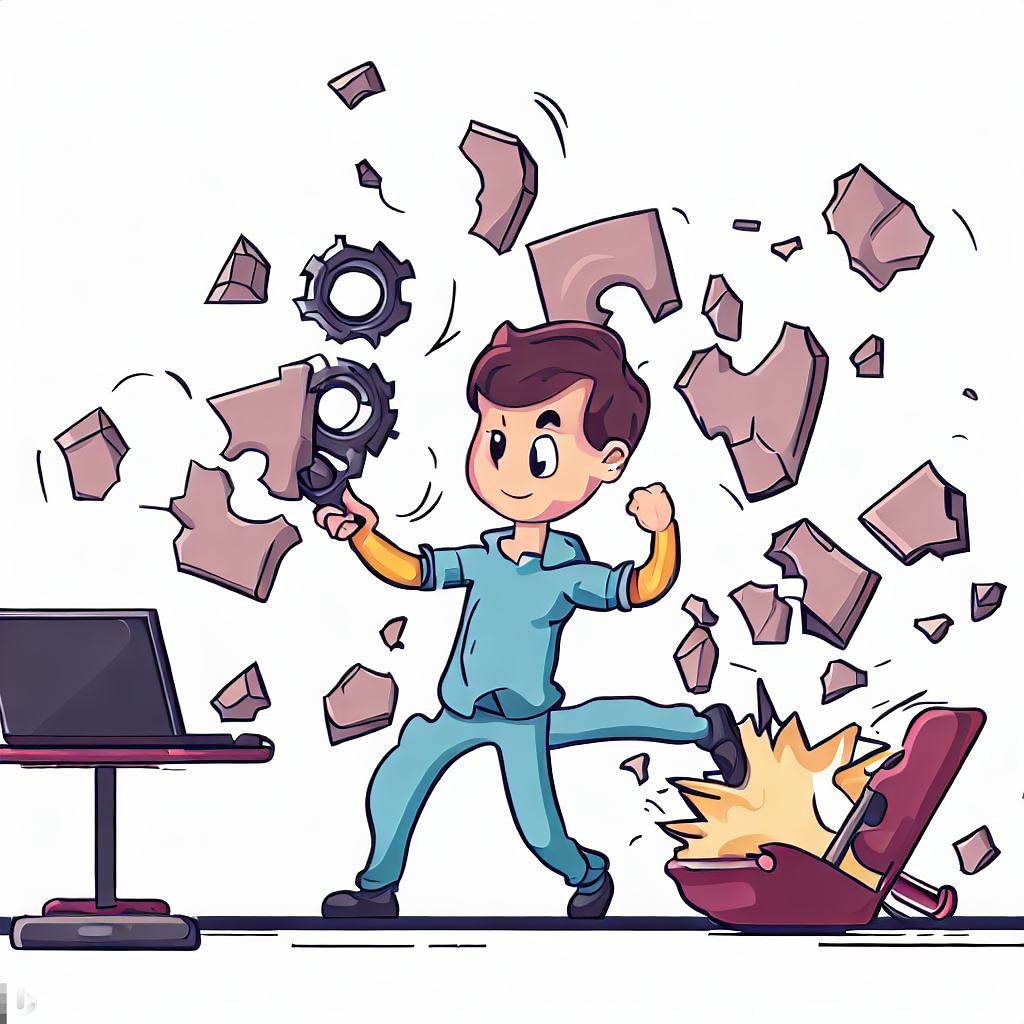Quick and easy top 10 list for time management and productivity increase:
- Prioritize your tasks (Write a 2-do-list)
- Set goals
- Use a planner or calendar
- Break tasks into smaller pieces
- Eliminate distractions
- Take breaks
- Use the Pomodoro technique (see the end of the article)
- Delegate tasks when possible
- Learn to say “no”
- Get enough sleep
Let’s take an in-depth dive into a few of these time management advices in the list above.
Create a To-Do List

Write down tasks and prioritize them. If you’re not sure where to start, try making an Excel spreadsheet or using one of the many free task management apps available online.
Use a physical or digital list that you can update as needed throughout the day (or week).
Set Clear Goals and Prioritize

The first step to achieving your goals is to set them. You should know what you want to achieve and how long it will take, as well as the steps needed to get there.
Once you have defined your goals, break them down into manageable pieces. This will help keep them from seeming overwhelming or impossible. This is an invaluable time management tip. It also helps ensure that every task has a purpose in moving forward toward the completion of the overall goal.
Prioritize tasks according to importance: work on those items first that are most critical for reaching your end result so that they don’t fall by the wayside due to lack of time or energy on your part later on down the road when things get busy again (or worse yet – never).
Estimate the Time Required for Each Task
When you’re estimating the time required for each task, be realistic. Don’t assume that everything will go smoothly and on schedule. If you do this, you’ll find yourself constantly putting off important tasks because they seem too difficult or time-consuming. Instead, account for unexpected delays and add extra time for complex tasks that might require more research than originally planned.
You can also use the Eisenhower Matrix as a tool to help you decide which tasks are most important in order to better manage your time.
The Eisenhower Matrix is a time management tool that helps you prioritize tasks based on their urgency and importance. It was named after former US President Dwight D. Eisenhower, who was known for his ability to make tough decisions and manage his time effectively.
The matrix consists of four quadrants, each representing a different level of urgency and importance:

- Urgent and important: These are tasks that require immediate attention and have a significant impact on your goals or well-being. They should be tackled first.
- Important but not urgent: These are tasks that contribute to your long-term goals but don’t require immediate attention. They should be scheduled and worked on regularly.
- Urgent but not important: These are tasks that require immediate attention but don’t contribute to your long-term goals. They should be delegated or postponed.
- Not urgent and not important: These are tasks that have little or no value and should be eliminated or minimized.
“If you seek tranquility, do less. Or (more accurately) do what’s essential. Do less better. Because most of what we do or say is not essential. If you can eliminate it, you’ll have more tranquility.” — Marcus Aurelius
By using the Eisenhower Matrix, you can focus on the most important tasks and avoid wasting time on less important or unnecessary tasks. It can help you prioritize your work and make more effective use of your time.
Block Out Time in Your Calendar
If you’re like most people, your workday is filled with meetings and appointments that take up a large portion of your time. You may also have personal commitments that need to be scheduled, such as doctor’s appointments or errands. It can be difficult to find time for important tasks when there are so many distractions vying for your attention. That’s when you need time management tips to solve your problem.
To help combat this problem, block out specific blocks of time in your calendar for specific tasks (such as “write blog post”). This will help keep you focused on what needs doing without being distracted by other obligations or projects that aren’t urgent right now but might become so later down the road if left unchecked until then!
Break Tasks into Smaller Pieces

One of the best ways to boost your productivity is the time management tip that states you should break tasks into smaller pieces. This allows you to focus on one step at a time, which is much easier than trying to tackle an entire project at once.
For example, if you have a big report due in two weeks and don’t know where to start, break down the task into manageable steps: research topic and outline; draft first draft; revise second draft; proofread final copy. Then set deadlines for each step so that they’re not too far apart from each other (for example: “Research topic” should be done within three days).
The philosopher who is famous for the problem-solving technique of breaking a problem into smaller pieces is Aristotle. He believed that it was easier to solve a problem if you broke it down into smaller parts and then solved each part separately. This concept is called analytical thinking.
Take Regular Breaks

Taking regular breaks is an essential part of time management. When you’re working on a task, take a break every 30 minutes or so. Your brain needs time to recharge and relax after focusing on one thing for a while, so don’t be afraid of taking breaks!
When you’re taking your break, focus on something else–anything that doesn’t require much thought or effort will do the trick (like watching some TV). If possible, try not to think about work at all during this time; just let yourself relax and recharge before getting back into it again when the break is over. Read more about a special “taking-a-break technique” at the end of this article (Pomodoro).
Delegate Tasks

Delegate tasks that can be delegated. If you are the only person who can do a certain task, then don’t delegate it! But if there is someone else who has the skills and time to complete the task, consider passing it off to them.
Delegate tasks to the right people. This can be done with the help from a freelancer on Fiverr or Upwork. Make sure that you are delegating tasks based on their strengths and interests rather than just because they’re available or cheap (or both). For example: if I’m looking for someone who loves Excel spreadsheets but hates writing blog posts, then I would not assign them my next blog post assignment–even though they were free!
Set clear expectations and deadlines when delegating work so everyone knows what’s expected from them and when they need to get back with results/progress updates etc.
Eliminate Distractions to improve time management
Turn off notifications. You don’t need to be notified every time someone likes your Instagram post or retweets your tweet. Notifications can be distracting, so turn them off and only check social media when you have time to do so.
Limit social media use during work hours (or at least set a timer). If you’re trying to get work done and find yourself constantly checking Facebook or Twitter, try setting a timer for 15 minutes of social media use per hour and then refocusing on what matters most: getting things done!
Find a quiet place where no one will bother you! This is especially important if there are other people around who might distract from what needs to be done – whether it’s coworkers or family members coming into your office space unannounced with questions about last night’s dinner plans (or worse yet…they want help!). If possible, find somewhere else within walking distance that doesn’t have as much foot traffic (like an empty conference room) where nobody will bother me while I’m working on my project today.”
Learn to Say No

When you’re overwhelmed with work, it can be tempting to take on every task that comes your way. But this is a bad idea–you’ll end up feeling stressed and unproductive. Instead, learn how to say no when someone asks you for help or asks you to do something that isn’t important enough for your time. If they’re truly a friend or colleague who needs assistance, then offer them some advice instead of getting involved in their project directly (and remember: sometimes people just want someone else’s opinion).
Don’t forget about prioritization! It’s easy for us all-too-human beings to focus on the most urgent tasks at hand while ignoring those things we know will benefit us long term; however, this can lead us down a path toward burnout if we don’t keep an eye out for ways we can improve our productivity levels without sacrificing our mental health along the way. Make sure every day has at least one item on its agenda that helps build up skills or knowledge needed later down the road–it could be anything from reading or translating articles related to current events affecting business owners today through online resources such as Entrepreneur magazine’s website where authors share tips based on their own experiences running businesses successfully over time periods ranging anywhere between two years up until thirty years plus beyond into retirement age!
What is the Pomodoro technique?
The Pomodoro technique is a time management method that was developed in the late 1980s by Francesco Cirillo. The technique involves breaking down work into intervals, typically 25 minutes in length, separated by short breaks. These intervals are referred to as “Pomodoros.”
The idea behind the technique is to improve focus and productivity by working in short, focused bursts. During a Pomodoro, you focus on a single task without any distractions or interruptions. After the Pomodoro is complete, you take a short break, typically 5 minutes, before starting the next Pomodoro.
After completing four Pomodoros, you take a longer break, typically 15-30 minutes. This break is an opportunity to recharge and refocus before starting the next set of Pomodoros.
The Pomodoro technique can be used for any type of work, whether it’s studying, writing, or coding. By breaking work down into manageable intervals and taking regular breaks, you can improve your productivity, time management and reduce the likelihood of burnout with these time management tips.

